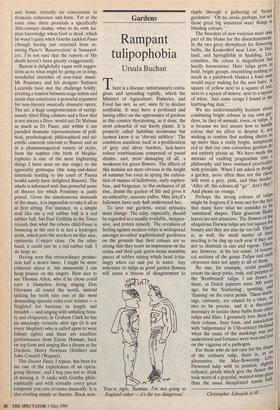Gardens
Rampant tulipophobia
Ursula Buchan
There is a disease, unfortunately conta- gious and spreading rapidly, which the Ministry of Agriculture, Fisheries, and Food has not, as yet, seen fit to declare notifiable. It may have a profound and lasting effect on the appearance of gardens in this country threatening, as it does, the most colourful of our hardy plants. It is properly called Subtilitas inveteratus but laymen know it as 'chronic subtlety'. The condition manifests itself in a proliferation of grey and silver borders, lack-lustre colour combinations composed of pastel shades, and, most damaging of all, a weakness for green flowers. The effects of this malaise are most obvious in the height of summer but even in spring the cultiva- tion of masses of hellebores, early euphor- bias, and bergenias, to the exclusion of all else, drains the garden of life and gives it an unhealthy, anaemic pallor. Miss Jekyll's followers have only half understood her.
To save our gardens, social attitudes must change. The tulip, especially, should be regarded as a readily available, inexpen- sive, and potent remedy. The revulsion of feeling against modern tulips is widespread amongst so-called 'sophisticated' gardeners on the grounds that their colours are so strong that they leave an impression on the retina and their pale green stems resemble pieces of rubber tubing which bend irrita- tingly when cut and put in water. Any reference to tulips as good garden flowers will cause a frisson of disagreement to 'You're right, Batman. I'm not going to England either — it's far too dangerous: ripple through a gathering of 'better gardeners'. 'Oh no, tarda, perhaps, but not those great big unnatural waxy things in blinding colours.' The breeders of new varieties must take part of the blame for the disenchantment. In the two great showplaces for flowering bulbs, the Keukenhof near Lisse, in Hol- land, and Springfields in Spalding, Lin- colnshire, the colour is magnificent but hardly harmonious. Here tulips grow to bold, bright groups, resembling nothing so much as a patchwork blanket a fond aunt would enjoy making for the new baby. A square of yellow next to a square of red, next to a square of mauve, next to a square of white. 'Just some scraps I found in the knitting-bag dear.' We are understandably hesitant about combining bright colours in our own gar- dens, be they of annuals, roses, or tulips. It is because we feel unsure how to handle colour that we affect to despise it, not wishing to confess that nothing cheers us up more than a really bright, sumptuous red or that our own colourless gardens do not entirely please us. We have made the mistake of exalting pragmatism into . a philosophy and have confused practicality with principle. When I am asked to design a garden, more often than not the client will want a grey, pink, and blue border. 'After all, the colours all "go", don't they? And please no orange.' Perhaps the strong colours of tulips might be forgiven if it were not for the fact that many have what we consider to he 'unnatural' shapes. Their glaucous fleshY leaves are not attractive. The flowers of the ubiquitous Darwin tulips are too square for beauty and they are also far too tall. There is, as well, the small matter of their needing to be dug up each year if they are not to diminish in size and vigour. 'Mel.e are, however, at the last count, 16 botani- cal sections of the genus Tulipa and each objection does not apply to all of them. No one, for example., could possiblY. resent the deep pinks, reds, and purples of the 'Rembrandt' tulips. I am drawn t° them, as Dutch painters were 300 years l ago, for the 'feathering', spotting, and 'flaming' on the outer petals. These maw ings, curiously, are caused by a virus, or two to be precise, and it is therefore necessary to isolate these bulbs from other tulips and lilies. I genuinely love them for their colours, freer form, and association with `tulipomania' in 17th-century when the cause of the markings was n°t. understood and fortunes were won and lost on the vagaries of a pathogen. For those who do not care for the shaPc of the ordinary tulip, there is, as . an alternative, the May-flowering .1-11 Holland Flowered tulip with its pointed, slight Ye reflexed, petals which give the flower the look more of a graceful, waistedwine-gla,s,s than the usual decapitated tennis hall' Christopher Edwards is ill.
Even the Early Double tulips (with flowers not unlike double paeony, though smaller) have charm.
Stiff and uncompromising in habit, tulips are best planted amongst small shrubs or fast-growing hardy perennials so that only the heads and a small amount of stem may be seen; and, if grown amongst bedding, sweet williams and wallflowers are better foils than the usual forget-me-nots. I confess that 'Deutschland', with its awful combination of red, black and yellow resembling, presumably, the German flag, will find no place in my garden but, those mixtures of yellow and red apart, there are few tulips I could reject outright, provided I had space enough to quarantine them from any clashing neighbours. For those who wish for permanent and perennial tulips, the choice lies mainly amongst the small species tulips which
grow best in rock-beds, such as the orange chrysantha, the red linifolia, and the start- ling scarlet praestans Fusilier. It is cheering how much colour can be tolerated, by even the most fastidious eye, when set against the cool grey of limestone chippings.
Miss Jekyll was not frightened of using orange flowers and found plenty of room for tulips. Those of us who claim to be her disciples must relearn what she taught about the correct use of striking colour if • Our gardens are not, visually, to waste away.



















































 Previous page
Previous page